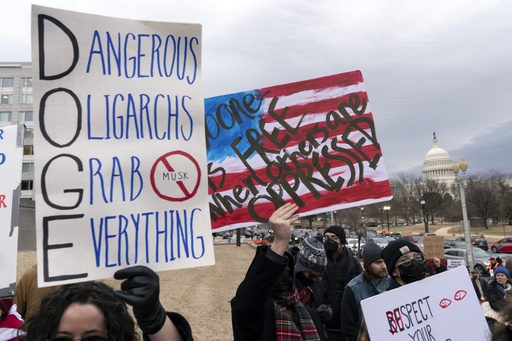WASHINGTON — Last month, U.S. employers added a total of 143,000 jobs, marking a modest opening to 2025 as the unemployment rate decreased to 4%. This initial jobs report under Donald Trump’s second term suggests a steady, albeit uninspired, labor market. Job creation for January was notably lower than the 261,000 jobs added in November and the 307,000 in December, with economists having anticipated an increase of around 170,000 jobs for the month.
As Trump gears up to revise economic strategies by reducing federal positions, imposing significant tariffs on foreign goods, and taking measures to deport millions of undocumented workers, the economic forecast remains uncertain. His initiatives, including tariffs and immigration reforms, might propel prices upwards, potentially reviving inflation that previously alienated many U.S. voters from President Joe Biden, facilitating Trump’s return to office.
At present, the majority of Americans are enjoying notable job security. However, for job seekers, competition has intensified compared to the bustling job market from 2021 to 2023. Wages saw a rise of 0.5% from December, and an impressive increase of 4.1% from January 2024, surpassing analysts’ expectations. Although this may dampen some hopes for curbing inflation at the Federal Reserve, buoyant productivity growth in the U.S. is tempering some of the wage inflation. This productivity allows businesses to offer higher wages and enjoy greater profits without necessarily increasing prices.
Gregory Daco, chief economist at EY Parthenon, notes that while employers are holding onto their workforce, they are neither making significant new hires nor initiating widespread layoffs. Daco anticipates that average job growth may temper to between 100,000 and 150,000 jobs a month throughout the year, a slight downturn from the 2024 average of 166,000 new jobs each month. Additionally, the Labor Department adjusted previous payroll figures for November and December, reflecting a combined increase of 100,000 jobs.
Analysts from High Frequency Economics, Carl Weinberg and Mary Chen, stated that recent upward adjustments indicate no immediate concern regarding economic vitality based on the employment report. However, they also suggested that recent hiring trends imply the Federal Reserve is unlikely to rush into interest rate cuts after three reductions in 2024.
The job growth in January was relatively constrained, with significant contributions coming from healthcare (44,000 jobs), retail (34,000), and government (32,000), together accounting for 77% of all new jobs created. Meanwhile, the mining sector experienced a decrease of 8,000 jobs. The Labor Department indicated that recent wildfires in Los Angeles and a cold spell in the Northeast and Midwest did not notably affect January’s employment statistics.
Looking ahead, uncertainties loom. A federal judge recently issued a temporary restraining order against Trump’s plan to incentivize the reduction of federal employees. Economists, including Bradley Saunders from Capital Economics, noted that the hiring freeze Trump enacted on January 20 could hinder employment growth. Concerns are also rising regarding Trump’s threats to initiate a trade conflict with other nations, having already instituted a 10% tax on imports from China while signaling potential tariffs on Canada, Mexico, and the European Union.
These tariffs, typically borne by U.S. importers and subsequently passed onto consumers, could exacerbate inflation — which, having decreased since mid-2022’s peak, still remains above the Federal Reserve’s 2% target. If prices escalate due to tariff imposition, the Fed may have to reconsider or delay its anticipated interest rate cuts, potentially hindering economic expansion and job growth. Additionally, businesses express concern regarding Trump’s commitment to deporting millions of workers who are essential to the U.S. labor force.
Companies like Coastal Luxury Outdoors in Florida highlight the challenges they face with workforce shortages attributed to reliance on immigrant labor. Rafi Friedman, the company’s president, emphasizes that despite potential reductions in demand owing to tariffs, staffing needs must still be met. He explained that over 80% of their field staff comprises Hispanic workers, many of whom are immigrants, and that verifying their immigration status is a standard practice.
The job market is already showing signs of losing momentum. In the past year, U.S. payrolls rose by 2 million, a drop from the 2.6 million seen in 2023, 4.6 million in 2022, and a high of 7.2 million in 2021, which followed the recovery from COVID-19 lockdowns. Employers have been advertising fewer job openings, with monthly job offerings decreasing from a record 12.2 million in March 2022 to 7.6 million in December, which still represents a healthy historical figure.
For instance, Aujanique Star, a 20-year-old pre-nursing student from Fife, Washington, has struggled for nearly a year to transition from caregiving to a retail role. Despite submitting as many as 20 application forms, she continues to encounter rejections, leading her to question what she is missing despite her work experience and loyalty to her roles.
As the labor market cools down, American workers are gradually losing confidence in their ability to improve their pay or working conditions by moving jobs, as indicated by a decline in the number of people choosing to quit their jobs. This number decreased from a high of 4.5 million in April 2022 to just 3.2 million in December, falling below pre-pandemic levels.
In its regular annual reassessment, the Labor Department reported a downward adjustment in job growth for the year spanning April 2023 to March 2024, totaling 589,000 fewer jobs than initially reported. Earlier estimates published in August had suggested a higher anticipated downward revision of 818,000 jobs.
The White House press secretary indicated that the economic conditions during Joe Biden’s presidency were unexpectedly poor. However, Trump is stepping into an economy characterized by a commendable unemployment rate and stable conditions, albeit not one that is likely to meet his expectations.
As Trump looks to stimulate the economy through tax cuts and deregulation, his federal funding freezes might stymie infrastructure projects and manufacturing growth. His tariffs could negatively impact the retail industry, while spending cuts may restrict hiring within healthcare and government sectors.



